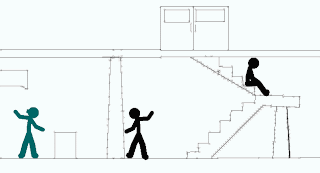Squash and Stretch
One of the main principles of animation is Squash and Stretch. This type gives a sense of weight and flexibility of drawn objects. Simple objects such as bouncing balls can have a comical effect. The main purpose of this principle is that the objects volume would not change when it is squashed or stretched.
Anticipation
The purpose of the anticipation animation is used to prepare the audience for an action, this also makes it look more realistic. For example a baseball player could be swinging his arm back before he makes his pitch. This technique can also be used for less physical actions. An example of this could be a focusing on the attention of a certain object which a character is about to pick up.
Staging
This principle is known in both theatre and film. The main purpose of staging is to direct the audiences attention and to show the audience the greatest importance of a scene. For example what is happening and what is about to happen. An idea can be based on many things such as personality, expression or even a mood. This is then created by either the placement of a character, the position or angle of a camera and most of all focusing on what is relevant.
Straight ahead action and pose to pose
Both straight ahead action and pose to pose have different approaches to the actual drawing process. This is because straight ahead action is drawing a scene beginning till end using frame by frame. Whereas pose to pose involves drawing a few frames and the filling in the intervals at a later stage. Straight ahead action creates more of a dynamic illusion of movement and is better for creating realistic action sequences. However pose to pose works better on dramatic or emotional scenes. This is where composition and relation to the surroundings are of greater importance. Both Techniques are often combined together.
Follow through and overlapping
These closely related techniques help make movements look more realistic. The technique follow through is used for separate parts of the body so that the part of the characters body is still moving after the character has stopped. However overlapping action means that different parts of the body can move at different rates. For example movements of the arm and head can move at different times.
Slow in and slow out
This principle can be used in either the human body or certain objects. This is where movements need time to slow down, therefore an animation will look more realistic if it has more frames from the start of the beginning and towards the end of a movement and possibly fewer in the middle. An example of this is when a character will be moving through two extreme poses, such as the character sitting down then standing back up. However this can also be used for objects such and a ball bouncing up and down.
Arcs
This principle is used for the humans body and animals. These actions occurs along arched trajectory. Animation should also produce these movements for a much greater realism. For example this can apply to a limb moving by rotating a joint or an object that has been thrown moving along a parabolic trajectory.
Secondary action
This principle gives scenes more life and can help to support the main action. For example a person would be able to express his emotions through facial expressions. Or by the character either swinging their arms or keeping them in their pocket. The main focus of secondary action is that they emphasize, rather than taking away actions from the main action. In the case of facial expressions It is better to include at the beginning and end of a movement because during a dramatic movement they may be unnoticed.
Timing
Timing is given to the number of drawings or frames for a certain action. This will then translate to the speed of the action or film. Having the correct timing makes objects appear to be abide to the laws of physics. For example an objects weight can decide how it will react to a impetus. Timing for a characters mood, emotion or reaction is critical. Certain aspects can also bring out the characters personality.

Exaggeration
This principle is especially useful for animation. The level of exaggeration can depend on whether one seeks realism or a particular style. This can be seen as either a caricature or even the stylist of an artist. A classical definition which is employed by Disney is to have the scene remain true to reality although just presenting it in a much wider and more extreme form. however other forms can include supernatural and surreal, this can also involve elements in the storyline itself. If there are several elements in a scene then should be a balance in how those elements are exaggerated in relation to each other.
Solid drawing
This principle means taking into account forms in three-dimensional space. Therefore the animator will need an understanding of three-dimensional shapes, weight and even light and shadow. Modern day computer animators draw because of the facilities they are provided with. however their work will benefit greatly from a basic understanding of animation principles.
Appeal
The main purpose of this principle is for the viewers to feel that the characters is real and interesting. There are also several tricks to show how the character can connect better with the audience. For example likeable characters such as symmetrical or particularly baby-like face can tend to be more effective with the audience.











No comments:
Post a Comment